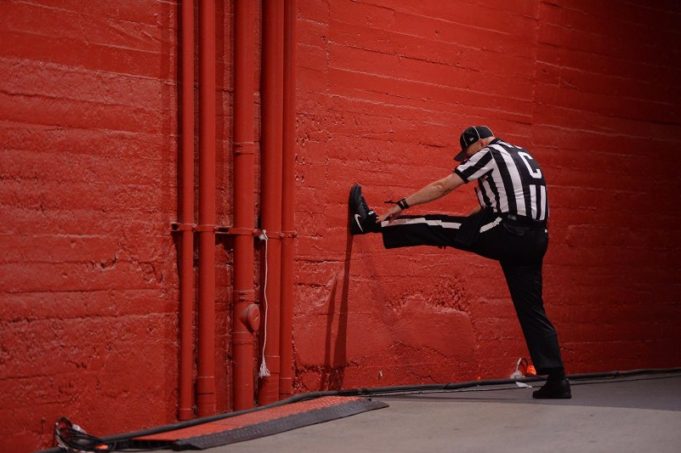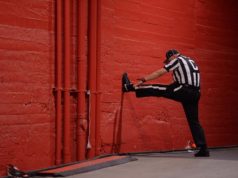Expert Strategies to Keep You Limber and Safe
Decreasing the risk of injury is always a solid reason to not skip a warm up. However, just like with an actual workout routine, you can sometimes get bored from the same old movements day in, day out.
Properly warmed up muscles stretch longer and can tolerate more stress, which is reason enough to do them. That said, many referees still have trouble finding a warmup that is right for them or just wanting to skip it all together. Perhaps the generic routines you find online don’t cover enough of a specific body zone that applies to your sport or maybe they take too long for your liking.
Whether you’ve been struggling with your current warm up routine, or you just want to try something new, here are three different things you can try that will help improve both your current warm up routine and also fine tune your in-game performance.
Tip 1: Dynamic stretching to keep things moving (literally)
Stretching before any physical activity can help prevent muscular injuries, and there are two types of stretches you can do; dynamic stretches and static stretches. They serve different purposes and due to the nature of the sports official position, the former is the best way to stretch.
Dynamic stretches are stretches you do while moving to warm up certain muscles and muscle groups, and static stretches are moves that stretch the muscle while you hold that stretch in place.
As an official, you have to move quickly with bursts of power and speed during a game. Having that dynamic flexibility is imperative for safer, explosive movement as warming up dynamically gets your muscles to their “working temperature” sooner rather than later.
Lastly, static stretches don’t really bring an air of urgency with them. Rather, they encourage rest (think of pre-bed time stretching to encourage relaxation and calmness). The last thing you need before you hit the court or field is to feel sleepy.
Is this to say you shouldn’t do any static stretches at all? Well no, but the majority should be dynamic simply because of your professional requirements. A word of caution before you begin: if you’ve never done dynamic stretching before, or it’s been a long time since your last rodeo, start slowly and gently. Some recommended stretches you can start with are the lunge and reach, cossack squat, knee hugs and walking toe touches.
Tip 2: Get intentional, early on
Coming hot off tip #1, dynamic stretching gets you ready for powerful movement much faster, so it’s important to be intentional with your stretching work early on to improve overall function and power. It’s a common misunderstanding that warmups are supposed to not be challenging and they should be restful. Unless you’re getting ready for bed, you want to prep your body (and, your mind!) up for what you’re about to do, and you want to do it quickly.
Your warm up speed should be on the same level as your game speed. You might not be used to this method just yet, but in a relatively short amount of time, your body will adapt and you’ll be more adequately prepared.
The warmer your muscles will get, more quickly, the better. It’s efficiency 101.
Some suggested intense warm ups include: High Knees (20s interval), Quick Feet (10 yds), Split Lunge (20s interval), Jumping Jack with a Side Shuffle (20 yds)
Tip 3: Timing is everything
Timing applies here in two different ways.
If you’re doing intense, dynamic warm ups, it’s important to get it over with quickly, and the science is there to back it up. Warm ups that are shorter in duration are more effective in preparing the body than longer ones.
Since you’re utilizing dynamic movements that get your muscles warmer faster, there’s no reason to spend more than 5-10 minutes on a warm up.
You also don’t want to exhaust yourself before your job even begins, so it’s counterproductive to make a warmup last any longer than that.
Additionally, the timing of your warm up is key. It doesn’t make much sense to warm up too early before your game begins, because then your body will start to cool down. In fact, warming up too early can actually have a negative effect on your overall performance.
The trifecta of warm up science
The name of your warm up game should be just that – to warm up. By moving more intensely and dynamically, you’ll achieve a higher core temperature and warm, lengthened muscles ready to deliver explosive, on-point movement when you need it most.
References:
1. McHugh, M.P., and C.H. Cosgrave. “To Stretch or Not to Stretch: The Role of Stretching in Injury Prevention and Performance.” Scandinavian Journal of Medicine and Science in Sports, 10 Mar. 2010, https://onlinelibrary.wiley.com/doi/full/10.1111/j.1600-0838.2009.01058.x
2. Herman, Sonja., and D.T. Smith. “Four-Week Dynamic Stretching Warm-up Intervention Elicits Longer-Term Performance Benefits.” Journal of Strength and Conditioning Research. July 2008, https://journals.lww.com/nsca-jscr/Fulltext/2008/07000/Four_Week_Dynamic_Stretching_Warm_
up_Intervention.36.aspx
3. Zois, James, et al. “High-Intensity Warm-Ups Elicit Superior Performance to a Current Soccer Warm-up Routine. “Journal of Science and Medicine in Sport, Elsevier, 9 Sept. 2011, https://www.sciencedirect.com/science/article/abs/pii/S1440244011000740
4. Taylor, Johnathan, et al. “The Effect of a Short Practical Warm-up Protocol on Repeated Sprint Performance.” Journal of Strength and Conditioning Research. July, 2013. https://cdn.journals.lww.com/nsca-jscr/Fulltext/2013/07000/The_Effect_of_a_Short_Practical_Warm_up_Protocol.35.aspx
5. Silva, L.M., et al. “Effects of Warm-Up, Post-Warm-Up, and Re-Warm-Up Strategies on Explosive Efforts in Team Sports: A Systematic Review.” Sports Medicine. 2 July, 2018.
https://link.springer.com/article/10.1007/s40279-018-0958-5
What's Your Call? Leave a Comment:
Note: This article is archival in nature. Rules, interpretations, mechanics, philosophies and other information may or may not be correct for the current year.
This article is the copyright of ©Referee Enterprises, Inc., and may not be republished in whole or in part online, in print or in any capacity without expressed written permission from Referee. The article is made available for educational use by individuals.



















